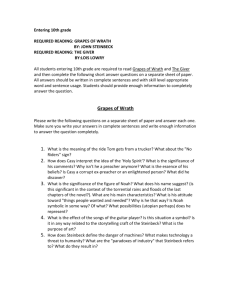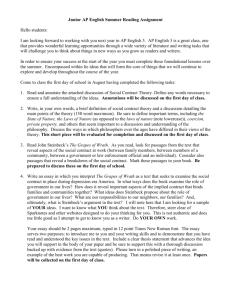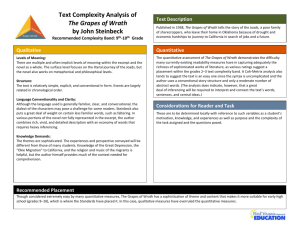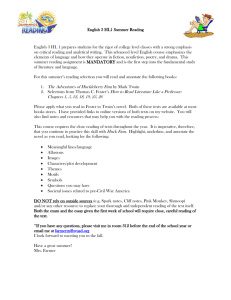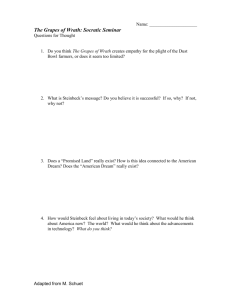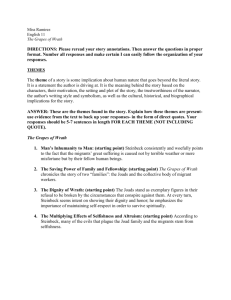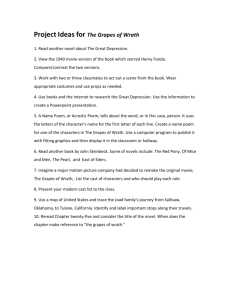Lesson 1: Unit Overview PowerPoint
advertisement
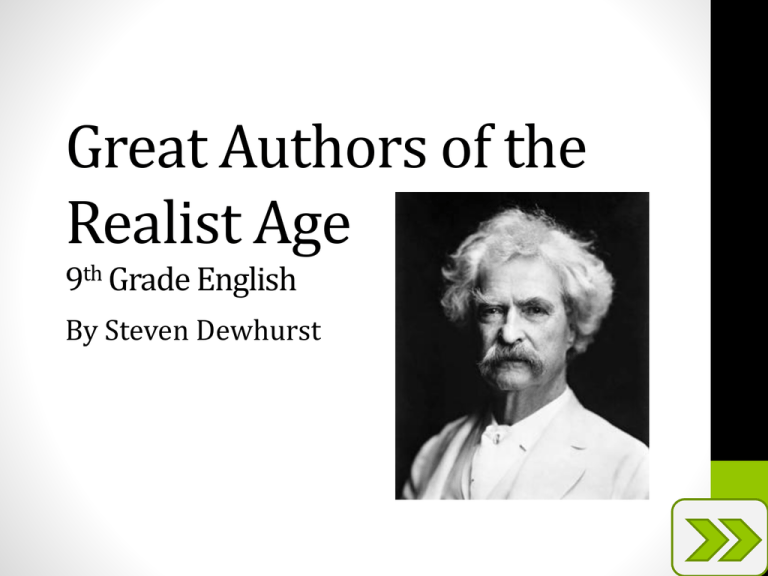
Great Authors of the Realist Age 9th Grade English By Steven Dewhurst By Steven Dewhurst Introduction • Welcome to your 9th grade Intro to Great Literature course! During this unit, you will learn about many famous realist authors and you will read some of their works. In this presentation, you will learn about four well-known authors and one work from each of them, and then take a short quiz. Have fun! Navigation Icons Usage • previous/next slide icon • return to title slide icon • return to main menu icon • return to question icon Main Menu Mark Twain Arthur Miller Ray Bradbury John Steinbeck QUIZ!!! Mark Twain Overview • Born/Died: Nov 30, 1835 – April 21, 1910 • Notable Works: • • • • The Adventures of Tom Sawyer Adventures of Huckleberry Finn A Connecticut Yankee in King Arthur’s Court The Chronicle of Young Satan (unfinished) • Other Notable Events: • became a licensed steamboat captain in 1859 • newspaper reporter for the Virginia City Territorial Enterprise Early Life • born in Florida, Missouri in 1835; moved to Hannibal at age 4, lived there until age 17 • real name: Samuel Langhorne Clemens • “worked as a storekeeper, lawyer, judge, and land speculator” • had a negative outlook on life • father died in 1847; mother became leader of household, Twain quit school to provide for family Writing Huckleberry Finn • written over many years • received much negative criticism upon publication, even from his own wife • became very popular, regardless; had big influence on modern American literature • "All modern American literature comes from one book by Mark Twain called Huckleberry Finn” –Ernest Hemingway • Huck Finn’s success allowed Mark to earn a lot of money from future works Huckleberry Finn and Romanticism • Twain had a distaste for Romantic literature • Examples in Huckleberry Finn: • Tom Sawyer: Huck’s friend; counters Huck’s realistic mindset with fantastic stories of adventure • Sir Walter Scott: the name of a famous Romantic writer; the name of a sunken steamboat on the Mississippi River • Grangerford/Shepherdson feud: parodies Shakespeare’s Romeo and Juliet • The Duke and the King: two characters that use false personas to con the common folk out of money and valuable possessions Later Life • Twain headed west in 1861 to look for gold and silver (failed) • got a job as a reporter, and his stories became popular • was well-known, popular author by 1869 • married Olivia (Livy) Langdon in 1870, and loved her very much; had four children • eventually, three of the children and Olivia died of disease • Twain lived out his remaining years as a broken man You have finished this section. Click the icon to your right to return to the Main Menu. Arthur Miller Overview • Born/Died: October 17, 1915 – February 10, 2005 • Notable Works: • Death of a Salesman • All My Sons • The Crucible • Other Notable Events: • married to Marilyn Monroe • refused to help the House of Un-American Activities Committee “out communists” Early Life • lived in Harlem, New York until the Wall Street Crash of 1929; moved to Gravesend, Brooklyn • attended University of Michigan after high school • wrote his first play, No Villain • took courses with professor Kenneth Rowe • Rowe’s approach to playwriting inspired Miller’s pursuits Death of a Salesman • “Miller wrote the first act…in less than a day” • opened at Morosco Theatre on February 10, 1949 to critical acclaim • was Miller’s first success and most famous work • “won him the triple crown of theatrical artistry: the Pulitzer Prize, the New York Drama Critics’ Circle Award, and a Tony” Death of a Salesman (Cont.) • play protagonist, Willy Loman, is losing his touch as a salesman in old age • Salesman criticizes the American Dream: • • • • seemingly impossible to be financially successful does “comfortable” living really make you happy? work ethic doesn’t equate to success pursuit of American Dream negatively affects mental/physical health, family relations • Willy struggles with all of these issues Later Life • continued to struggle with “the weightiest of societal and personal matters” • “last play of note was The Price (1968), a piece about family dynamics” • third wife died in 2002; planned to marry Agnes Barley, but died of heart attack in 2005 at age 89 You have finished this section. Click the icon to your right to return to the Main Menu. Ray Bradbury Overview • Born/Died: August 22, 1920 – June 5, 2012 • Notable Works: • Fahrenheit 451 • The Illustrated Man • The Martian Chronicles • Other Notable Events: • studied in local library as substitute to college education • wished works to be considered fantasy rather than sci-fi • had a distaste for TV, but wanted his works to be adapted Early Life • born and raised in Waukegan, Illinois; later used childhood events in short stories • loved reading about magicians and action and fantasy genres • decided to become a writer between age 12-13; wanted to be immortalized with his work • moved to Los Angeles in 1934, joined the drama club • studied in a library “’three days a week for 10 years,’” since he lacked money for the college due to the Depression Fahrenheit 451 Controversy • published in 1953; “Bradbury’s best-known work” • “became an instant classic in the era of McCarthyism for its exploration of themes of censorship and conformity” • gained both praise and criticism/suspicion • “In 2007, Bradbury himself disputed that censorship was the theme of Fahrenheit 451, instead explaining the book as a story about how television drives away interest in reading”. Fahrenheit 451 • future where all books are banned and burned • penalty for possession of books is death or banishment from society • main character, Guy Montag, is a fireman who burns books • meets a strange girl, Clarisse; begins to start thinking for himself • conflict resides with Montag’s unwillingness to change/inner desire for freedom • friends and family begin to see changes; harder to hide his intellectualism • is it better to conform and be safe, or risk safety to express individuality? Later Life • “wrote for several hours every day throughout his entire life” • “wrote well into his 90s;” daughters would write his words for him • ended up publishing over 30 books, 600 short stories, etc. • won many awards, but favorite was becoming the United States Pavilion’s “’idea consultant’” for the 1964 World’s Fair • accepted his branding as a science fiction/fantasy author; said that other people’s opinions “’don’t count’” to him You have finished this section. Click the icon to your right to return to the Main Menu. John Steinbeck Overview • Born/Died: February 27, 1902 – December 20, 1968 • Notable Works: • The Grapes of Wrath • Of Mice and Men • Tortilla Flat • Other Notable Events: • dropped out of college to pursue writing • Won a Pulitzer Prize for The Grapes of Wrath • “served as a war correspondent for the New York Herald Tribune during World War II” Early Life • father worked many jobs to keep family fed; mother was a schoolteacher • was shy, but smart; lived a modest but happy life with his three sisters • “formed an early appreciation for the land…which would greatly inform his later writing” • decided to become a writer at age 14 • enrolled at Stanford University in 1919, but dropped out in 1925 The Grapes of Wrath Overview • published in 1939 • about a family starting a new life in California during the Great Depression • “Widely considered Steinbeck's finest and most ambitious novel…” • “sold 10,000 copies per week” • “earned Steinbeck a Pulitzer Prize in 1940” The Grapes of Wrath and the Depression • John spent time with affected families; was disgusted by the suffering they were subject to • settled on an approach after visiting a camp in Bakersfield, CA • was loved and hated upon publication: • some loved its honest portrayal of life during the Depression • some accused Steinbeck of expressing Communist ideals • many Californian farmers were offended at the book’s portrayal Later Life • became war correspondent during WWII • Went to Gulf of California with Edward F. Ricketts; collaborated on the book Sea of Cortez • “continued to write in his later years” • awarded the Nobel Prize for Literature in 1962 • “died of heart disease on December 20, 1968” You have finished this section. Click the icon to your right to return to the Main Menu. Question 1 • Which of these characters do not represent Twain’s satirical views of Romanticism in Huck Finn? 1. Tom Sawyer 2. Twain’s wife 3. Shepherdsons Two Sides of the Same Coin • Nope, sorry. Tom Sawyer is one of the strongest representations of Romanticism in the novel. While Huck is very realistic, Tom is constantly reworking stories of adventure that he reads, which sometimes makes it difficult for Huck to interact with Tom concerning real-world issues. Go ahead and try again! The Bad Sheep • Not quite. In the novel, the Shepherdsons were having a feud with the Grangerfords, which satires William Shakespeare’s Romeo and Juliet. Twain cements his distaste for Romanticism by taking the formula in an even more absurd direction, in which the families no longer even remember why they are fighting, but continue to do so anyway. Try again! Transforming Love • Correct! Mark never alludes to his wife in the novel. He also held her in very high regard, hoping that she would help him to become more cultured and proper. Well, time to move on to the next question! Question 2 • Which of these claims does Death of a Salesman criticize about the American Dream? 1. Comfortable living (i.e. steady job, strong income, possessions) provides happiness 2. Pursuit of financial success strengthens one’s mental and physical health 3. Strong work ethic always brings success 4. All of the above Can’t Pay Your Way Out • Yes, the fickleness of happiness stemming from money is criticized. Willy believed that his efforts would bring him happiness, but instead he became even more stressed as time went on. However, there’s a better answer. Go back and try again! Money on My Mind • True, the main focus of the play is Willie’s back-and-forth between reality and his mental illusions, but there’s still a better answer. Try again! Love of Money is the Root of All Evil • Correct! All of the answers were criticisms from the play! You seem to be well-grounded in reality, unlike a certain salesman we all know. You may move on to the next question! Work Hard. Play Hard? • It is true that despite Willie’s vigorous efforts, he was undercut as a man and a salesman, but there’s still a better answer. Why don’t you try again? Question 3 • True or False: Ray Bradbury himself claimed that Fahrenheit 451 was about television making people lose interest in reading, rather than about more general themes of censorship and conformity. 1. True 2. False Maybe the Curtain’s Just Blue… • Nope, sorry. This is a great example of how readers can be so sure that they understand the message an author is trying to convey, but still end up getting it wrong or looking too deep. It doesn’t mean that your interpretations can’t mean anything to you, but sometimes that blue curtain is no more than a blue curtain… Try again! TV Rots Your Brain • Correct! Maybe you feel the same way as Bradbury, or maybe you don’t, but that’s what he said! It’s time to move on to the final question! Just don’t leave any burn marks… Question 4 • Which of these statements about The Grapes of Wrath is not true? 1. Farmers were offended by how the book portrayed them 2. Steinbeck was accused of Communism because of the book’s themes 3. The book was universally hated at the time of its publication Importance • Nope, sorry. Despite the fact that Steinbeck wrote The Grapes of Wrath out of his heartache for these people’s living conditions, many farmers were still offended by his work. Try again! Baby’s a Red • Steinbeck was accused of expressing Communist sympathies within the themes of The Grapes of Wrath. It was actually quite common for the great writers of the time to be accused of such things. Go ahead and try again! Love It, Hate It • Correct! Despite receiving a lot of negative criticism, The Grapes of Wrath received a lot of positive attention as well, and it has continued to grow in popularity as an excellent example of the hardships of the Great Depression and also its continued relevance to modern society. You may proceed to the end of the presentation! The End • Congratulations, you have completed the Great Authors of the Realist Age unit overview! Continue on to the next slide to finish! Sources • "Arthur Asher Miller." Bio. A&E Television Networks, 2014. Web. 24 Sep. 2014. • "John Ernst Steinbeck Jr." Bio. A&E Television Networks, 2014. Web. 08 Oct. 2014. • "Ray Bradbury Douglas." Bio. A&E Television Networks, 2014. Web. 01 Oct. 2014. • "Samuel Langhorne Clemens." Bio. A&E Television Networks, 2014. Web. 24 Sep. 2014. • Shmoop Editorial Team. "The Grapes of Wrath." Shmoop.com . Shmoop University, Inc., 11 Nov. 2008. Web. 8 Oct. 2014. You have finished this unit overview. Please click the icon to your right to return to the title screen for the next student.
